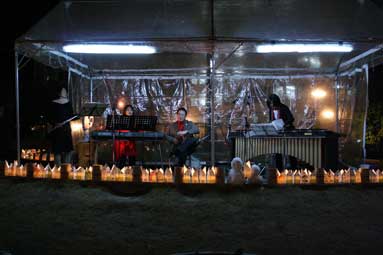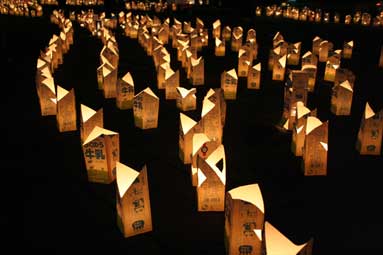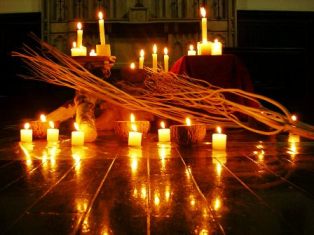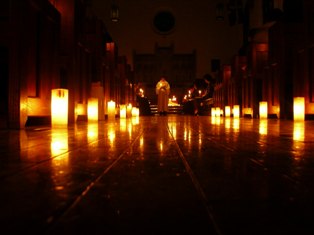2006.04.06
Fire disappeared from Japanese homes
What has dramatically changed in Japanese households is the role of "fires." It is shown in the way we count houses. In Japan, we count them like 1 (ichi)-ken or ikken, 2 (ni)-ken, in which the suffix -ken means "eave." However, in the old days, we counted them as 1 (hito)-he, 2 (futa)-he with the suffix -he, which comes from an ancient word hettsui, another name of kamado. It is an old-style cooking stove where people cooked meals in a cooking pot called a kama with burning fires.
When we count the houses based on the number of cooking stoves, we could be confused if there are more than one stove in a house. In old days, each house only had one kamado so that we could get an accurate count. Why? In those days, a Japanese house was built by first putting in a fireplace at its center, then building the walls around it. If you have seen a pit dwelling, you can easily picture what the home was like.
Later, the fireplace was replaced by an irori, an open hearth. While the homes had another main room with a tokonoma, a decorative room used to welcome guests or to celebrate special events, families sat around the irori and had happy times together in everyday life. The head of the family and his wife were supposed to keep the same seats around the irori.
In spacious farmers' houses, the irori had been the center of the house for quite a long time. However, irori had to be eliminated in merchants' because they had different lifestyles and housing. Even if there were no irori in a house, the head of the family always sat just behind a nagahibachi, an oblong brazier. The place just behind the fire was reserved for the master of the family. Fires had long been at the center of people's lives, wherever they lived. The Japanese saying, "Don't put out fires of tradition," which is similar to an English expression, "Pass the torch," comes from living with traditions like this. The fire-centered lifestyle can also be seen in Europe where an old house has a living room with a fireplace at its center.
Nowadays, Japanese houses do not have an irori, or nagahibachi, not to mention a fireplace. A place for burning fires has been shoved in the kitchen corner. Fire has lost its honor to be the center of people's lives, now only used as a tool for cooking. Today, most people may have a hard time understanding the meaning of "Fires are sacred." In Japanese, Olympic torch means seika (sacred fires). However, not many people can remember the origin of the word.
Fire has been regarded as sacred not only because it can be frightening, but also because it sheds light to the darkness. When I was a college student, two friends and I traveled around the Izu Peninsula with no money. One night we were invited to stay overnight with some farm workers. Wasabi, Japanese horseradish, was cultivated in the mountain area in Amagi. Many people working in the area spent nights in huts near the crops. They talked and talked while burning wood in the irori. The fires lit their faces brightly. When the wood fires burned out, the world turned into the utter darkness. People fell asleep on the floor of the hut.
At no other time in my life had I realized that a fire is light more than that night. The introduction of the electric light bulb changed the role of fire as light. Today it is totally taken over by electricity. Fire is now seen as a fuel, only existing in gas stoves.
This means that each house does not necessarily have a place for a fire. I was filled with deep emotion when I read an advertisement for ready-built housing, featuring "separate kitchens for a two-family home." This home would be for elderly parents and their grown children's family, who used to live together and use one kitchen as one household. It was the end of the thousand-year history of the lifestyle that put fires at the center of the home.
A fire today no longer sheds light in the dark night or symbolizes the center of people's lives.
Our lives, perhaps, have become too convenient.
Although our homes have become more functional, the loss of fires in the home means Japanese people have lost another sacred space.
An excerpt from Nihonjin no wasuremono, (English translation: Things
left behind among Japanese people), written by Susumu Nakanishi, published by Wedge Corp., Japan.
Translation: Candle Night Committee
2006.04.06
Milk carton lanterns lighting up Kumamoto
In December 2005, after overcoming many difficulties, a Candle Night event titled "Candle de Night" was held for the first time in Kumamoto City. Even though everyone who was involved agreed they must do something good for the environment, putting the plan in motion was another matter. The committee spent tireless hours discussing how to move forward with the event.
Wondering how to move on
Kumamoto Prefecture is located in the middle of Kyushu, the southern island of Japan. Its land area is about 7,404 square kilometers, nearly seven times the area of Hong Kong and about a half that of Northern Ireland. Seventy percent of the land is covered with forest. Kumamoto City, the capital of the prefecture, faces the Sea of Ariake, with a population of about 670,000.
In March 2005, responding to a call from Kumamoto Prefecture, a conference for environmental action networking was held. Environmental organizations in Kumamoto and the prefectural government discussed how to jointly take measures and actions towards environmental issues in the prefecture. Mr. Hiroyuki Yamada, an organizing member of the Candle de Night Committee recalled the meeting and said, "At the meeting all agreed to take action, but it was difficult to move on to the next steps, such as holding the event and taking some initiatives."
Then, in June 2005, another meeting was held in which the Kumamoto branch of OISCA Japan played a central role. Organizations from businesses, municipal government and NPOs/NGOs that had gathered at the previous meeting participated in this meeting as well. During the meeting, all agreed
to take action. They formed an organizing committee to discuss how to take concrete steps towards creating initiatives. Then, in August 2005, they held the "sprinkling water" event to cool down the summer heat, and in December of the same year, they held the "Candle de Night" event.
Feeling warm in the heavy snow
On December 21, 2005, Kumamoto was hit by a cold wave for the first time in decades. The prefecture suffered heavy snow storms.
Karashima Park, where the event was held, is located at the center of the city. At the event, a gospel concert was held and handmade milk carton lanterns were decorated by the local citizens. Prior to the gospel concert, an instrumental concert was held where musicians played the marimba and the violin. Since it was very cold during the event, warmed wine was distributed to the participants.

(Photo courtesy: Candle de Night Committee)
About 50 volunteers, ranging from business people to students helped with the event. Nearly 500 people ranging in age from their 20's to their 40's gathered at the event.
At the event, an objective of the committee's initiative was put as follows:
"Aiming at Japan's highest milk carton recycling rate."
The nation's average recycling rate of milk cartons is about 20 percent, but Kumamoto Prefecture's is 16.7 percent. By decorating milk carton lanterns, the group tried to beautifully display candles while at the same time, improve citizen's awareness for recycling. Recycling boxes for milk cartons were placed at the event site. On that night, about 5,000 milk cartons were brought to the event. The milk carton lanterns softened the candlelight and shed beautiful light on the park.

(Photo courtesy: Candle de Night Committee)
Spreading Candle Night in Kumamoto Prefecture
"Even among the organizing committee members, the actual players were limited. Getting consensus in the committee was also painstaking," told Mr. Yamada. However, due to their efforts, Candle Night is steadily spreading in the prefecture. On May 27, 2006, Tamana City, another city in Kumamoto, plans to hold a Candle Night event. They plan to hold concerts, such as "wadaiko" (Japanese drums), marimba and a brass band at five locations in the city. They will decorate milk carton lanterns using waste oil and encourage the citizens to join "Candle Night Summer Solstice 2006."
To realize an idea, you should take action and shape it through trial and error. Once the idea takes its own form, it will spread more and more. People's passion for the environment is spreading in Kumamoto, using "candles" as a symbol.
(Yuko Kisikami)
2006.03.03
Candle Night Winter Solstice 2006--Rikkyo University
The Ikebukuro Campus of Rikkyo University, Tokyo, held a Candle Night event on December 22, 2006, under the title of "Candle Night Winter Solstice in Rikkyo--Turn off the lights and light a fire in your mind." This was the second Candle Night at the university. The first event was held the summer of the same year. Gaining support from university organizations such as the Office of the Chaplains and the Volunteer Center, students established an organizing committee for the event. Making plans and preparations for the event took over several months.

How has the Candle Night in Rikkyo taken its form?
In the spring of 2005, a poet who graduated from the university made a proposal to have a poetry workshop during a Candle Night event. It would be an opportunity to think about and share "our happiness" together. The proposal inspired the student environmental groups to hold the first Candle Night event in the summer of 2005, hoping to spark environmental awareness in their community.
The 2005 winter event was held on the last day of class, just before the winter holidays. Every year, Rikkyo University's symbol, a cedar tree, is decorated with illumination lights about a month before Christmas. It has been one of Tokyo's tourist spots in winter. The famous Christmas illumination was turned off on one night, and instead a tree made of candles was supposed to be lit. Since this is the second Candle Night event in Rikkyo, many people supported and helped the event. Thus, the winter event focused on the people who gathered there, their reflections over the year 2005, and their feelings. Requiem was also one of the focuses of the event. So many lives were lost due to devastative natural disasters in 2004 and 2005, as well as, war and terrorism, despite the world's wish for peace.
The event started at 17:00 with candle service at the chapel. Compared to the summer event, it was already dark at 17:00, and all participants realized how short the day on the winter solstice. After the service, participants moved to a classroom, and joined a poetry workshop over fair-trade coffee. The theme of the workshop was "meets Memory." All the participants looked into their mind and to make poems. Then, they watched an interview with the promoters of the Candle Night Committee, Ms. Miyako Maekita, Mr. Shinichi Tsuji, Mr. Kazuyoshi Fujita and Mr. Shinichi Takemura and the video footages of Ache in Indonesia, which was devastated from the Indian Ocean Earthquake and Tsunami, and the places ruined by large earthquake in northern Pakistan. Watching these images, each participant thought about the year's events on their own.

Then, the participants went outside for the countdown event--turning off the lights of the symbolic cedar tree, university buildings and facilities and streetlights. They were supposed to light the tree made of candles, but the winds were too strong. Each participant held a candle with a wind screen attached while listening to the student's hand bell performance.
Rikkyo University is located in Ikebukuro, Tokyo, one of Japan's major downtown areas. It is always surrounded by hustle and bustle, completely opposite from a "slow world." Twice a year, spending slow nights under the theme of "Turn off the lights, take it slow" has been very important. It would be a great pleasure if the Candle Night event could help change people's lives as well as the environment in the surrounding area.
(Article and photo: courtesy of Rikkyo University Candle Night Committee)

